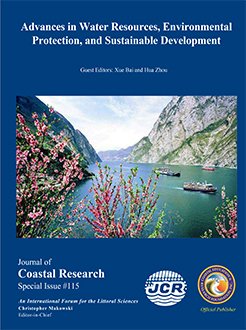Dou, Y.; Shao, P.; Gao, J.W.; Jia, X.Y., and Zhou, W.L., 2020. Effects of the culture conditions on growth and photosynthesis indices of Thalassiosira weissflogii. In: Bai, X. and Zhou, H. (eds.), Advances in Water Resources, Environmental Protection, and Sustainable Development. Journal of Coastal Research, Special Issue No. 115, pp. 696-699. Coconut Creek (Florida), ISSN 0749-0208.
Thalassiosira weissflogii is a marine resource microalga with practical applications in aquaculture and preparation of new nanomaterials, therefore the approach to culture conditions of T. weissflogii is quite important. Batch culture methods were used to study the effects of salinity and light intensity on T. weissflogii cell density and chlorophyll-a (chl-a) concentration. The results showed that: (1) The optimal salinity level for T. weissflogii growth was 30‰, under which cell density and chl-a concentration were up to 8.22 × 105 cells·mL-1 and 887.5 µg·L-1, respectively; the relative growth rate was 0.183. (2) The optimal light intensity level was 36 µmol·m-2s-1, under which cell density and chl-a concentration were up to 6.83 × 105 cells·mL-1 and 1431.7 µg·L-1, respectively; the relative growth rate was 0.146. (3) Compared with inorganic nitrogen sources, (NH2)2CO could better increase the cell density and chl-a concentration of T. weissflogii. In the experiment, the maximum cell density and chl-a concentration of T. weissflogii in the (NH2)2CO treatment group were 3.67 × 104 cells·mL-1 and 279.25 mg·L-1, respectively. These findings determined the optimal salinity and light intensity levels for growth of T. weissflogii, and reflected the effects of nitrogen source composition on T. weissflogii, accordingly, provided a new insight and important references to growth regulation and intensive culture of T. weissflogii in the lab.





